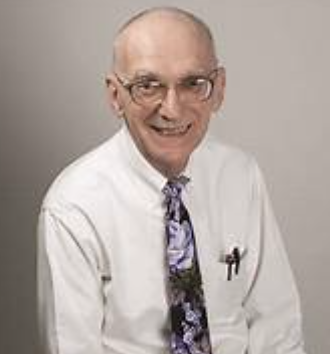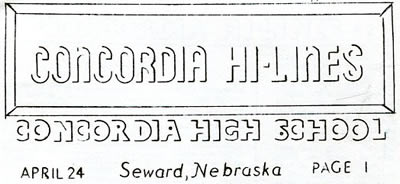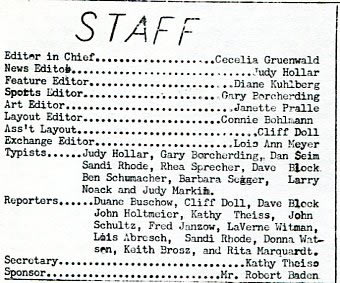

Thanks to Jerry Pfabe, archivist for Concordia University, for this written history of Concordia High School.
On May 18, 1972, 51 students graduated from Concordia High School. They were the school’s final grads. Concordia High ceased operations that year, largely due to financial concerns.
The high school had been an integral part of the teacher training institution which opened its doors with a dozen students in Seward, Nebraska, in November of 1894. George Weller was the sole full-time instructor in that year, assisted part-time in music by Herman Martin, teacher at St. John School. The school was a three-year high school until 1905. Graduates who wished to continue their teacher training transferred to the Missouri Synod’s school at Addison, Illinois. The school added two years of “normal school” in 1905, allowing students to complete their entire teacher education program on the Seward campus. In 1908 a fourth year was added to the high school, or academy, program. In the 1918-19 school year, among the courses offered were Rhetoric, Agriculture, Parliamentary Law, and Bookkeeping. Until mid-century members of the faculty typically taught courses in both the high school and college programs.
In 1950, largely for accreditation purposes, Concordia separated the high school and college programs, Walter Juergensen became the principal of the high school. By the mid-1960’s the high school had exclusive use of Becker Hall for classrooms, library, and faculty offices.
Concordia High offered a full program of extracurricular activities. In the fine arts, students could participate in choir, band, and orchestra. The school published its own student newspaper, Hi-Lines, and eventually its own annual, The Torch. The Harlequins, a drama society, performed plays regularly, Interscholastic competition in football actually began at the high school level in 1920; a college team following a few years later. Students also participated in basketball, baseball, track, wrestling and swimming. The 1959-60 school year was a banner year for athletics. Concordia High won Class C championships in both basketball and baseball under Coach Bob Baden. In 1971 Don Baker and Alan Christian won gold metals in their weight class in the state wrestling tournament. In the school’s final years girls participated in volleyball, track and softball.
Concordia High School served students at Seward well for over seventy-five years. It was an excellent preparatory school for the college and, in its later years, provided practicum and student teaching experiences for college students. Its many living grads cherish fond memories of their years at Concordia High.
Sandi Rhode, new member of the Senior Class in September 1960, was also a new reporter on the CHS Hi-Lines staff. Her first assignment was to determine what were the favorite songs of CHS students. Her notes listed songs and student voters. The following Class of 1961 responses were recorded. To hear a sample of the song, click on the title and iTunes will have it for you.
Song | Artist | Voters |
|---|---|---|
Marv Johnson | Koolie, Donna, Rhea | |
Various | Georgia, Tom | |
Elvis | Lois A., Rosalyn | |
Roy Orbison | CeCe | |
Preston Epps | Connie | |
The Ventures | Sharon, Judy | |
Connie Francis | Rita | |
The Everly Brothers | Gloria | |
Elvis | Jim, LeRoy, Borch, John | |
Rebel Rousers | Keith, Ben | |
Joe Jones | Cliff | |
Ferante & Teicher | Dan | |
Bobby Vee | Sandi |
The September 27, 1960 edition of Hi-Lines reported these as the “Top Hits,” based on responses from students from all classes:
It’s Now or Never
Walk, Don’t Run
Let’s Have a Party
Theme from a Summer Place (Percy Faith)
Move Two Mountains
The Concordia Hi-Lines was published bi-monthly under rather primitive standards compared to today’s technology. The staff gathered in the Typing Classroom in the basement of Becker Hall. Typists had the job of typing up articles in columns which would match the 3-column layout of the paper. In order for the columns to be justified on both sides, we were told to type /// marks to fill the line. That would help to type the second draft on the mimeograph stencils. Art work was done by hand with a stylus and was rather primitive. Photos were not even considered.
During the week, reporters were assigned tasks and they brought their work to the work sessions. The final production was the task of the school secretary and distribution took place on a table outside the school library up on the 1st floor of Becker.


Concordia High School • Seward, Nebraska • Class of 1961